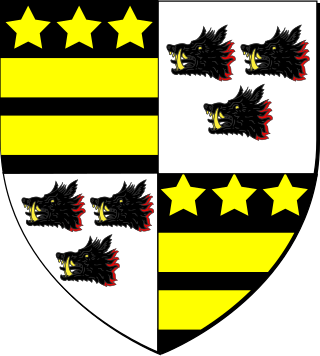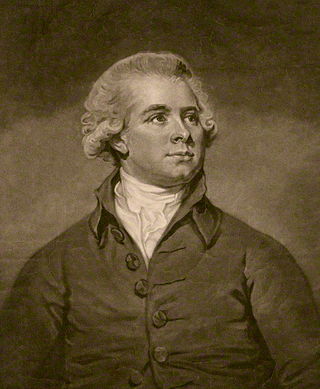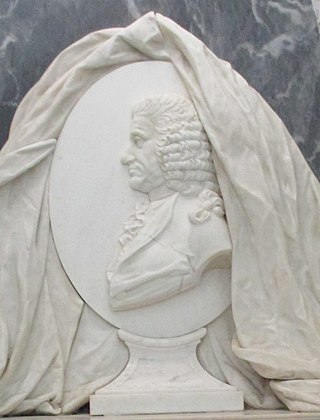
Baron Berners is a barony created by writ in the Peerage of England.

Earl of Chichester is a title that has been created three times, twice in the Peerage of England and once in the Peerage of the United Kingdom. The current title was created in the Peerage of the United Kingdom in 1801 for Thomas Pelham, 2nd Baron Pelham of Stanmer.

Viscount Gage, of Castle Island in the County of Kerry of the Kingdom of Ireland, is a title in the Peerage of Ireland. It was created in 1720 for Thomas Gage, along with the subsidiary title of Baron Gage, of Castlebar in the County of Mayo, also in the Peerage of Ireland. In 1744 he also succeeded his cousin as eighth Baronet, of Firle Place. The titles remain united. The Gage family descends from John Gage, who was created a baronet, of Firle Place in the County of Sussex, in the Baronetage of England on 26 March 1622. His great-grandson, the seventh Baronet, represented Seaford in Parliament. He was succeeded by his first cousin, Thomas Gage, 1st Viscount Gage, the eighth Baronet. He sat as a Member of Parliament for Minehead and Tewkesbury and also served as Governor of Barbados. In 1720, 24 years before succeeding in the baronetcy, he was raised to the Peerage of Ireland as Baron Gage and Viscount Gage. His second son was the military commander the Hon. Thomas Gage.

Baron Carbery, of Carbery in the County of Cork, is a title in the Peerage of Ireland. It was created in 1715 for George Evans, with remainder to the heirs male of his father and namesake George Evans, a supporter of William and Mary during the Glorious Revolution, who had earlier declined the offer of a peerage. After his elevation to the peerage, Lord Carbery represented Westbury in the House of Commons. He was succeeded by his eldest son, the second Baron. He also sat as Member of Parliament for Westbury. His grandson, the fourth Baron, briefly represented Rutland in Parliament. He was succeeded by his uncle, the fifth Baron. On his death, the line of the eldest son of the first Baron failed. He was succeeded by his first cousin once removed, the sixth Baron, who had previously succeeded his father as second Baronet, of Castle Freke. Lord Carbery sat in the House of Lords as an Irish representative peer from 1824 to 1845. His nephew, the eighth Baron, was an Irish Representative Peer from 1891 to 1894. As of 2014 the titles are held by the latter's great-great-grandson, the twelfth Baron, who succeeded his father in 2012.

Baron Henniker, of Stratford-upon-Slaney in the County of Wicklow, is a title in the Peerage of Ireland. It was created in 1800 for Sir John Henniker, 2nd Baronet, who had previously represented Sudbury and Dover in the House of Commons. His son, the second Baron, also sat as a Member of Parliament. In 1792 he assumed by Royal licence the additional surname of Major. He was childless and was succeeded by his nephew, the third Baron. He assumed the additional surname of Major by Royal licence in 1822. His son, the fourth Baron, represented Suffolk East in Parliament. In 1866 he was created Baron Hartismere, of Hartismere in the County of Suffolk, in the Peerage of the United Kingdom. This title gave him and his descendants an automatic seat in the House of Lords. He was succeeded by his son, the fifth Baron. He also sat as Member of Parliament for Suffolk East and later held minor office in the Conservative administrations of Benjamin Disraeli and Lord Salisbury. His grandson, the eighth Baron, was a prominent diplomat and notably served as British Ambassador to Jordan and to Denmark. As of 2014 the titles are held by the latter's son, the ninth Baron, who succeeded in 2004.

Baron Hotham, of South Dalton in the County of York, is a title in the Peerage of Ireland. It was created in 1797 for the naval commander Admiral William Hotham, with remainder to the heirs male of his father. Hotham was the third son of Sir Beaumont Hotham, 7th Baronet, of Scorborough, and in 1811 he also succeeded his nephew as eleventh Baronet. Lord Hotham never married and on his death in 1813 he was succeeded in both titles by his younger brother Beaumont, the second Baron and twelfth Baronet. He had previously represented Wigan in the House of Commons.

Viscount Maynard, of Easton Lodge in the County of Essex, was a title in the Peerage of Great Britain. It was created in 1766 for Charles Maynard, 6th Baron Maynard, Lord-Lieutenant of Suffolk. He was made Baron Maynard, of Much Easton in the County of Essex, at the same time, also in the Peerage of Great Britain. Both titles were created with special remainder, failing male issue of his own, to his kinsman Sir William Maynard, 4th Baronet. The 1st Viscount was unmarried and on his death in 1775 the baronetcy of Easton Parva, the Irish barony of Maynard created in 1620 and the English barony of Maynard created in 1628 became extinct. He was succeeded in the barony of 1766 and the viscountcy according to the special remainder by his kinsman Sir Charles Maynard, 5th Baronet, who became the 2nd Viscount. The latter was succeeded by his nephew, the 3rd Viscount, who served as Lord-Lieutenant of Essex. He had no surviving male issue and on his death in 1865 the baronetcy, barony and viscountcy became extinct. His granddaughter, Daisy Maynard, daughter of Colonel Charles Henry Maynard and future wife of Francis Greville, 5th Earl of Warwick, succeeded to most of the Maynard estates.
Baron Gwydyr, of Gwydyr in the County of Carnarvon, was a title in the Peerage of Great Britain. It was created on 16 June 1796 for Sir Peter Burrell, 2nd Baronet, who had earlier represented Boston and Haslemere in the House of Commons. The Burrell Baronetcy, of West Grinstead Park in the County of Sussex, had been created in the Baronetage of Great Britain on 5 July 1766 for his great-uncle Merrik Burrell, with remainder to the latter's nephew Peter Burrell. Merrik Burrell had previously represented Marlow, Grampound, Haslemere and Great Bedwyn in Parliament. Lord Gwydyr married Priscilla Bertie, 21st Baroness Willoughby de Eresby, herself a descendant of the Aberffraw legacy through her grandmother Mary Wynn. They were both succeeded by their eldest son, Peter Drummond-Burrell, 22nd Baron Willoughby de Eresby. On the death in 1865 of his son, the two titles separated. The Barony of Willoughby de Eresby fell into abeyance between the late Baron's sisters while the baronetcy and barony of Gwydyr were inherited by his cousin, the fourth Baron. He was the son of the Honourable Lindsey Merrik Peter Burrell, younger son of the first Baron. The baronetcy and barony became extinct on the death of his son, the fifth Baron, on 13 February 1915.
Peter Burrell, 1st Baron Gwydyr PC featured in English politics at the end of the 18th century, but he was best known for his involvement in cricket, particularly his part in the foundation of Marylebone Cricket Club in 1787.
There have been two baronetcies created for people with the surname Jenkinson, both in the Baronetage of England. The seventh holder of the first creation was elevated to the peerage as Earl of Liverpool in 1796, a title which became extinct in 1851.

Sir Merrik Burrell, 1st Baronet was a British politician.
Sir Percy Burrell, 4th Baronet DL, JP was a British Conservative politician.
There have been three baronetcies created for persons with the surname Bellingham, one in the Baronetage of England, one in the Baronetage of Ireland and one in the Baronetage of Great Britain. As of 2014 one creation is extant.

Baron Selsey, of Selsey in the County of Sussex, was a title in the Peerage of Great Britain. It was created on 13 August 1794 for Sir James Peachey, 4th Baronet, Master of the Robes to King George III. He was succeeded by his son, the second Baron. He represented St Germans and Shoreham in Parliament. His eldest son, the third Baron, was a Captain in the Royal Navy. The titles became extinct on his death in 1838.

The Pigot Baronetcy, of Patshull Hall in the County of Stafford, is a title in the Baronetage of Great Britain. It was created on 5 December 1764 for the politician and colonial administrator George Pigot, with remainder to his brothers General Robert Pigot and Admiral Hugh Pigot, and remains extant. On 19 January 1766 Pigot was further honoured when he was raised to the Peerage of Ireland as Baron Pigot, with normal remainder to the heirs male of his body. Lord Pigot was unmarried and on his death in 1777 the barony became extinct. He was succeeded in the baronetcy according to the special remainder by his brother, Robert, the second Baronet. He was a distinguished soldier.
There have been seven baronetcies created for persons with the surname Sinclair, six in the Baronetage of Nova Scotia and one in the Baronetage of Great Britain. Four of the creations are extant as of 2008.

There have been two baronetcies created for persons with the surname Goring, both in the Baronetage of England. The second creation came into the family through a special remainder in the patent creating the baronetcy. Only the latter creation is extant as of 2008.

Sir Charles Merrik Burrell, 3rd Baronet, was an English Conservative politician, who represented the seat of New Shoreham for fifty-six years, becoming Father of the House of Commons.

Sir Walter Wyndham Burrell, 5th Baronet JP was a British barrister, Conservative politician and Freemason.
The Raymond Baronetcy of Valentine House, in the County of Essex, was created in the Baronetage of Great Britain on 31 May 1774 for Charles Raymond, of Valentines, Ilford in Essex, who was High Sheriff of Essex from 1771 to 1772. It was created with remainder to his son-in-law William Burrell, who succeeded him as second Baronet. The latter was the nephew of the first Burrell baronet of the 1766 creation and the uncle of the first Baron Gwydyr. The third Burrell baronet succeeded to the title of Baronet Raymond of Valentine House on 20 January 1796.













